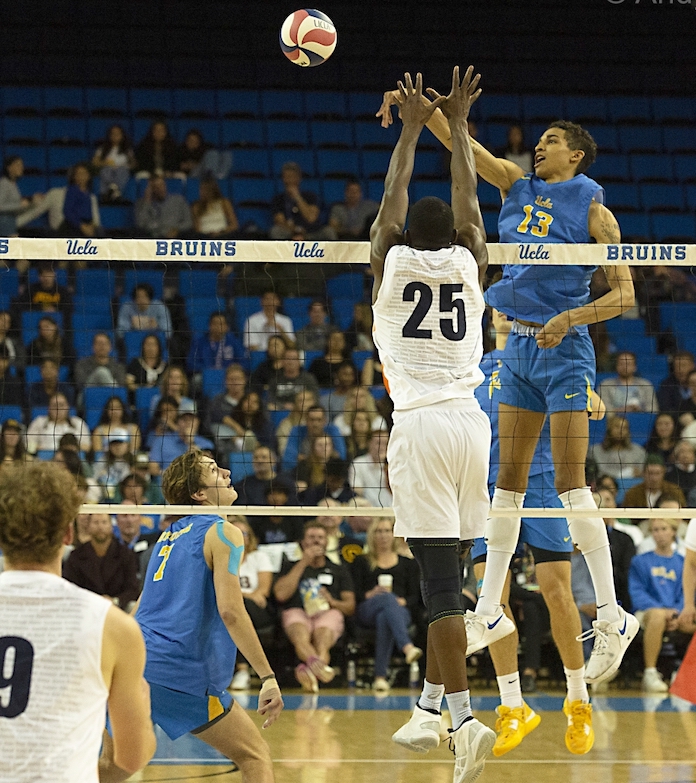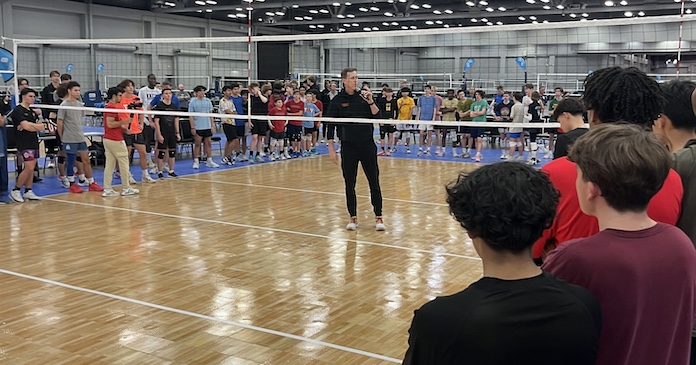Jim Wolf’s best photos from the UCLA-Long Beach volleyball title match
May 5, 2024
January 19, 2024

AUSTIN, Texas — Volleyball over football?
In Texas, that might qualify as some level of blasphemy.
But despite growing up in the Dallas area with a father and brother who played college football, Merrick McHenry didn’t have much interest. He was more enthralled with volleyball, having watched his mother coach club teams and being around that setting while he was in his formative years.
To say the least, McHenry, a 6-foot-7 senior middle blocker for the UCLA men’s volleyball team, was an outlier among his peers when it came to his chosen sport (though he also was a standout track and field athlete).
Nathan Lietzke understands.
Like McHenry, the fifth-year Stanford setter grew up here in Austin playing that “other” sport. His father, Glen, started Austin Junior Volleyball, where Nathan and McHenry were club teammates.
It was Lietzke’s only exposure to the sport. His high school, St. Andrew’s Episcopal School in Austin, didn’t even have a boys team until his senior season.
After some of his high school classmates came to see the boys team’s inaugural match — for many of them, their first time seeing the sport live — Lietzke vividly remembers their reactions.
“Some people came up to me from my school and said, ‘That’s probably one of the most fun high school sporting events I have ever been to regardless of sport.’ I’m like, ‘You guys should come watch my club team.’
“Merrick and I were traveling to all the big club tournaments, but they (classmates and friends) never got to see it here. It’s really fun to be a part of the growth process. From those experiences and showing my friends kind of highlights and film of the best people playing, I knew there was sort of an appetite there that was never really fed or tapped into.”
As Austin conducts the First Point Collegiate Challenge for the third time, there is growing evidence that those appetites are being fed. In the prior two years, the event, the brainchild of Glen Lietzke and backed by First Point Volleyball Foundation, has staged matches in front of strong crowds at Austin Convention Center.
It coincides with the corresponding Southwest Classic boys club tournament and team clinics.
Thursday night, 180 boys took part in drills and skill exercises demonstrated by each of the six teams at this year’s event: reigning national champion UCLA, Penn State, Stanford, Ohio State, Ball State and USC.
The number of boys participating was up more than 50 from last year.

“The moment Glen (Lietzke) sent me an email saying do you want to be a participant this year, I was the first to jump in,” USC coach Jeff Nygaard said, “because it’s an honor to be here and an honor to compete against all these teams, but it’s also an honor to help grow the sport.”
Nygaard, who grew up in Wisconsin and was a two-time NCAA champion on UCLA and a 1996 and 2000 Olympian.
“Me growing up, hearing about Texas volleyball wasn’t something on the road map … so any potential to grow our sport in America is a big deal. USC wants to be a part of that.”
Wade Garard, CEO and co-founder of First Point along with UCLA coach John Speraw, walked about the maze of courts as the college coaches and players put the boys through drills. He snapped pictures on his smartphone, chatting with participants along the way.
This is what he envisioned when the First Point Collegiate Challenge was launched. He said the event has exceeded his expectations, and he was effusive in his praise for the players giving of their time to instruct the youth.
“… In an NIL era where they are compensated often for this type of clinic work, to spend time with these young men and to be on the court with them, it matters a lot to them. It matters a lot to the parents,” Garard said.
Added USC redshirt junior opposite Jack Deuchar: “Hopefully, we can inspire as many of the young volleyball players as we can to continue to pursue the game for as long as they want to. And you can tell there’s an energy in the building going into the weekend.”
Stanford coach John Kosty has brought his team all three years. Like McHenry and Nathan Lietzke, he can appreciate their enthusiasm for seeing so many young men being introduced to volleyball.
When he got involved in the game five decades ago, he said, there weren’t AAU teams or club teams. There weren’t even high school teams in the vast majority of states.
“Where we were to where we are now and the support we are getting from both the AVCA and First Point, there are a lot of groups showing why men’s volleyball belongs in this country, why it belongs in high schools and why our game is growing at the collegiate level,” Kosty said.
“We are very prideful and privileged to bring our sport to a state that has not been known for its boys volleyball but produces great athletes and great volleyball players.”
During its brief — but impactful — run, the First Point Collegiate Challenge has operated on a “seeing is believing” mantra. In other words, it’s important to get eyes on the men’s game.
Having the Southwest Classic tournament that runs parallel with the collegiate matches, Garard said, makes it easy for kids to finish their competition then walk over to the next event room to see the “big boys” play.
“I do think the many head coaches here for years have talked about doing a couple of different things,” Speraw said. “One is doing events like this in combination with tournaments just for the exposure. So to have something like this exist is fantastic.
“The second thing we talked about was purposely scheduling matches in areas where we might be able to inspire growth. Can we go to places that don’t currently have extensive boys volleyball or collegiate teams in the area to show what we can do?
“If you see it live, it hooks you … so how can we get out and show other people our sport?”
McHenry noted that even if being exposed to volleyball doesn’t inspire everyone to play, it at least can raise interest for the sport and, perhaps, grow the fan base.
“More guys are showing interest, and they are asking me questions and they just want to know more about the sport,” McHenry said. “I think that has been a lot of growth, just to have more conversations when it comes to it. When I used to tell people about playing volleyball at UCLA it was just a foreign concept where now it is more accepted and people understand it.”
Ultimately, McHenry added, he is happy to see young boys have a chance to do something he didn’t at their age.
Of course, that doesn’t mean McHenry and the other college players don’t benefit from the First Point Collegiate Challenge. There’s plenty in it for them, primarily testing themselves against some of the country’s top teams.
Four of the six teams – UCLA, Ball State, USC and Ohio State – are making their first appearances. (McHenry noted he was “pretty salty the last two years watching this tournament go on and not being able to be a part of it.”)
Penn State is in for the second time, and all six — this is the first year the Challenge field has six teams, up from four — are ranked in the AVCA’s most recent poll. The coaches see it as kind of an “NCAA Tournament Lite.”
“This is something our guys have been talking about for a long time,” Ohio State coach Kevin Burch said. “And if you want to prepare a team for a national title run, you want challenges throughout the season, and there’s no better way to challenge them than be at a tournament like this.”
Added Penn State coach Mark Pavlik: “They have created an event that is very similar to what our student athletes will experience at the NCAA (Tournament) level. The structure, the scheduling, how the floor is laid out, the fans. I can’t speak highly enough about how this event has evolved over the past three years.”
Speraw called it “a preview of things to come at the end of the season.”
But perhaps more importantly, it’s a preview of what is to come for men’s volleyball.
“It’s also really cool that we get to be part of the clinic beforehand to actually get to interact with the kids,” Nathan Lietzke said. “I remember not too long ago when those kids would have been me and Merrick. Those are opportunities we didn’t have when we were in club, so it’s pretty cool to be able to give back to those kids.”
